These Chinese pork ribs are so tender that the meat almost melts off the bone!
It is called Wuxi Pork ribs (無錫排骨), the signature cuisine of Wuxi, a town in the Jiangsu 江蘇 province of China.
I want to introduce you to how to cook these famous Chinese pork ribs, characterized by the sweetness of rock sugar, the sourness of red vinegar 镇江红醋, and the flavor of Shaoxing wine. First, the braising liquid is cooked down and caramelized into a thick, luxurious red sauce with rock sugar, which enrobes the ribs.
The method is simple, but be prepared for prolonged braising, and you will be rewarded with the seductive flavor of this culinary wonder. You can easily make it with this recipe home instead of getting it from a Chinese restaurant.
Note: This post may contain affiliate links. Please read my privacy policy for more info. I may receive commissions for purchases made through links in this post. As an Amazon Associate, I earn from qualifying purchases.
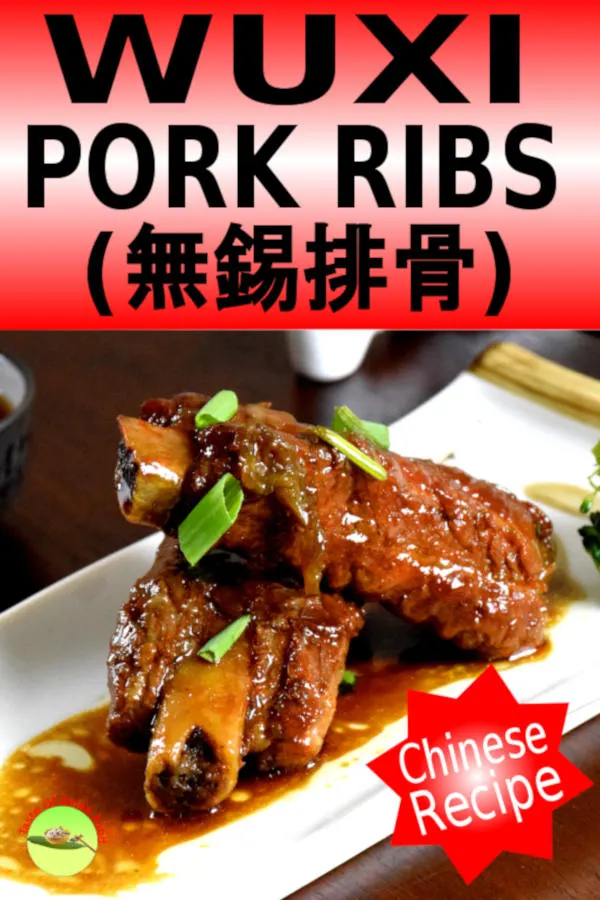
How to cook Chinese pork ribs- the step-by-step guide
Step 1- Marinate the pork ribs
Ask your butcher to cut the pork ribs crossways into long pieces. Next, I suggest you ask your butcher to cut the ribs into single-bone, square pieces. This is challenging at home as it requires a sturdy butcher cleaver.
You can use spare ribs (meatier) or baby back ribs (smaller but more tender. Generally, I prefer spareribs as it is the more meaty ones for this recipe.
Add light soy sauce and salt to the pork ribs and marinate for at least two hours. Marinating helps to enhance the flavor of the pork ribs. I also marinate the lean pork overnight with salt in another recipe—Cantonese Porridge with Lean Pork. Meat treated in this way can still retain the saltiness after prolonged simmering.
The amount of salt required is one percent of the ribs by weight. In this case, I use 10g (2 teaspoons) for one kg of pork ribs.
There is an alternate way to do it. Some cooks prefer to place the ribs in boiling water and blanch them for a few minutes. Remove and drain. This step will help to remove the impurities and porky smell of the ribs. You can do this after marination, as a few minutes of blanching will not remove the salt that penetrates deep into the ribs. You can skip this step by rinsing the ribs under running water if they are fresh and have no unacceptable smell.
Step 2- Get all the ingredients ready
Red yeast rice (optional)
Red yeast rice renders the ribs a beautiful red hue. Soak the rice in hot water for fifteen minutes to extract the color. Then, discard the rice and add only the colored water to the braising liquid.
Alternatively, tie the red yeast rice in a cheesecloth bag before adding it to the braising water. Remove the bag when the ribs become tender.
Red yeast rice (红曲米, Monascus Purpureus) is traditionally used by the Chinese chef to improve the color of various dishes. It is also used in our Chinese Roast Chicken recipe.
You can purchase red yeast rice in most Chinese medical halls and Asian grocery shops. Unfortunately, it is difficult even in certain Asian countries outside China. Omit it if you cannot find it, as it will not affect the taste. However, the color will not be as red as you expected.
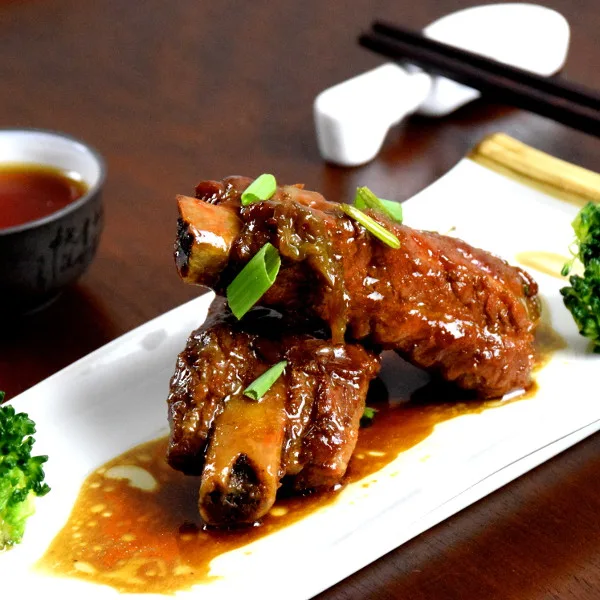
The Aromatics
There are some specific aromatics and spices for Wuxi pork ribs. Let’s examine each one.
Ginger. Ginger can remove any off-putting ‘porky’ smell. If you have a choice, use old ginger instead of the younger one for a better flavor. Some cooks prefer to slice the ginger, and others cut the ginger into small dice for sautéing.
Scallion. Scallions and ginger are always used side by side in Chinese cooking. Use scallion generously. It provides the flavor and helps prevent the pork ribs from sticking to the wok/pan during prolonged simmering. Reserve some chopped scallions to sprinkle on top of the ribs for garnishing.
Vinegar, sugar, and wine
The signature flavor of Wuxi-style Chinese pork ribs is from vinegar, sugar, and wine. There are numerous variations of the amount used, even in Wuxi itself, not to mention other outrageous adaptations elsewhere. However, these three ingredients must qualify as authentic Wuxi pork ribs.
Vinegar. The authentic Chinkiang vinegar from Zhejiang (浙江红醋) is. If you cannot get it, any other rice vinegar is an acceptable substitution.
Sugar. Rock sugar is preferred in this recipe. If you can’t get it, use castor or granulated sugar. Chinese Rock Sugar is irregular lumps of crystallized, refined sugar. It forms a translucent and glossy appearance on the pork ribs. The surface will be less glossy if you use regular sugar. Rock sugar should be added only after some time of simmering. Once it is caramelized, the gravy will stick to the surface of the pork ribs to form a glossy sheen,
Shaoxing wine. Use Shaoxing wine or any rice wine that will do the job. Dry sherry is another acceptable alternative.
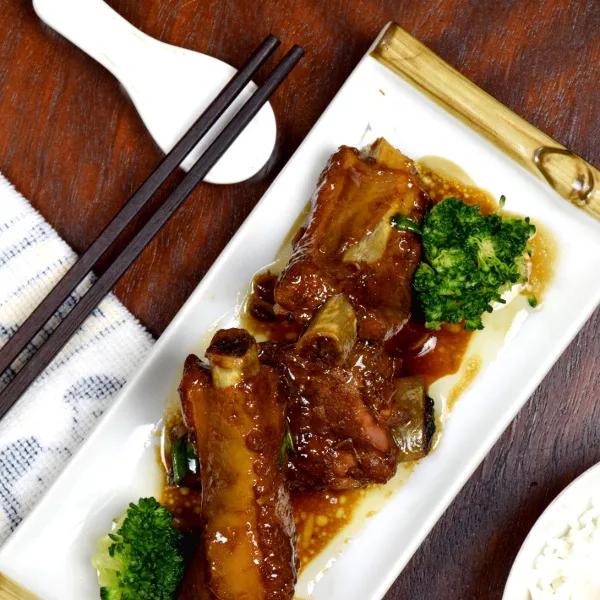
Star anise, cinnamon stick, and clove
The main spices for braised Chinese pork ribs, Wuxi style, are star anise and cinnamon. Clove, however, is omitted in some versions.
The flavor of star anise and cinnamon is quite intense, and a small amount goes a long way. I mention how many star points will be used in the recipe as the size of star anise varies. The same problem applies to the cinnamon bark: the bigger bark of the same length can be doubled in weight. Therefore, I am using the weight as the unit of measurement for cinnamon bark in the recipe for accuracy. (You may consider using a kitchen scale for this purpose.)
Light and dark soy sauce
Most of the recipes include a small amount of light soy sauce. I will not use dark soy sauce as the color of Wuxi pork ribs should be red, not black.
This recipe does not need Hoisin sauce, sesame oil, sesame seeds, chili peppers, Sichuan peppercorns, and five-spice powder. Instead, I prefer to keep it simple and delicious.
The signature flavor of Wuxi-style Chinese pork ribs is from the triumvirate of vinegar, sugar, and wine. These three ingredients are a must to qualify as authentic Wuxi pork ribs.
Step 3- Brown the pork ribs
Chinese restaurants generally deep-fry pork ribs for two minutes until the surface starts to turn color.
Deep frying adds more flavor to the ribs. This method is excellent, but if you want to save some oil or if it is not convenient to deep-fry at home, you can pan-fry the pork ribs instead.
Pan-frying can be as good as deep-frying. You need to add about 1/8 inch depth of oil to a frying pan, or at least if it is sufficient to cover the whole pan. Sear the ribs on both sides until the meat starts shrinking and the bone protrudes. When this is achieved, the color will turn a little brown. It is time to remove it and set it aside. Alternatively, you can use an air fryer to fry the ribs at home, which requires less oil.
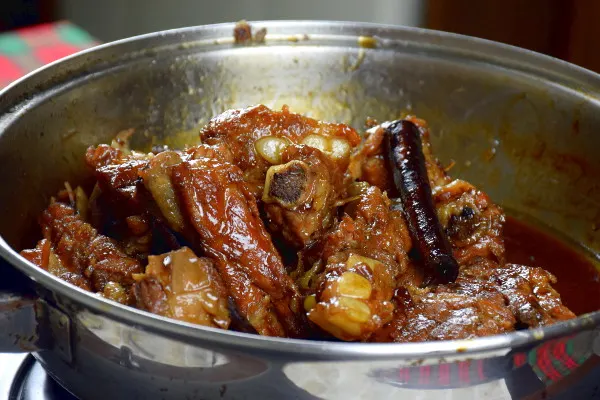
Step 4- Braise the pork ribs over low heat
Here are the steps:
- Saute the ginger and scallion in the wok until aromatic.
- Add the pork ribs that have been deep-fried into it.
- Add the wine, vinegar, salt, and soy sauce to the pan.
- Add water until it is just enough to cover the ribs.
- Bring the braising liquid to a boil over medium heat. Then, reduce the heat to a minimum, which is just hot enough to simmer it.
- Cover the pan with a lid. Simmer for about 30 minutes.
- The liquid should have reduced significantly by now. Open the lid and turn the ribs over to ensure even cooking.
- Add the rock sugar. If the amount is reduced too much, add some hot water. Otherwise, cover it again and braise for another 30 minutes.
- Remove the lid. Check the tenderness of the ribs. Press the spatula or chopsticks against the meat to check whether the meat is about to detach from the bone. The cooking time required to braise it until this tenderness depends on the heat based on visual observation. Cook for a longer time if it has not achieved the tenderness that you want. You should be able to poke through the meat with a chopstick without resistance.
- Once the pork ribs have the desired tenderness, cook down the liquid to become a sticky sauce.
- The gravy will coat the ribs to form a sticky glaze.
- Garnish with green onions to serve.
Note:
You can use a slow cooker for cooking it instead of on the stovetop.
Other related dishes to this Chinese spare ribs
Here is some other similar Chinese food that you will like:
- Garlic pork chop. One of my favorites is my original recipe 🙂
- Pork stir-fry with ginger and spring onions. The sister version of the beef stir-fry with ginger is equally delicious.
Braised Chinese pork ribs (Wuxi style) 無錫排骨

This Chinese pork rib is characterized by the sweetness of rock sugar, sourness of the red vinegar 镇江红醋 and the flavor from rice wine. The braise is cooked down and caramelized into a thick, luxurious red sauce, enrobed the ribs within.
Ingredients
Ingredients (A)
- 500 g pork ribs, , cut crosswise into single-bone pieces
- 1 teaspoon salt
- 1 teaspoon light soy sauce
- Blanched broccoli to garnish
Ingredients (B)
- 20 g ginger, , sliced
- 3 stalks scallions, , cut into 5cm length
- 5 cm cinnamon stick, , about 12g
- 6 star-points of star anise
- 6 pieces cloves
Ingredients (C)
- 2 tablespoons Shaoxing wine, , or any rice wine
- 1.5 tablespoons Rice vinegar
- 1.5 tablespoons light soy sauce
- 1/2 tsp five spice powder
- 1/2 tsp ground white pepper
Ingredients (D)
- 30 g rock sugar
- Water sufficient just to cover the ribs in the pan.
Instructions
Please refer to the text of the post for the details of each step.
- Cut the spareribs into single-bone pieces. Add the salt, light soy sauce, then marinate overnight.
- Blanch in hot water for three minutes to remove blood and impurities. Rinse and drain in a colander. (Optional step)
- Saute ingredients (B) with the oil in the pan until fragrant. Remove the aromatics.
- Heat the remaining vegetable oil in the frying pan. Pan-fried the spare ribs over medium heat until golden brown on both sides. Remove and set aside.
- Add ingredients (C). Bring the liquid to a boil and simmer for one hour over low heat or until the ribs become tender. Add water if necessary.
- Add ingredients (D).
- Remove the ribs from the braising liquid.
- Strain the braising liquid through a fine sieve. Reduce the liquid. Thicken with the 1/2 teaspoon of cornflour.
- Add the ribs back to the sauce. Coat the ribs with the sauce and reduce the sauce further until it becomes syrupy. Serve.
Recommended Products
As an Amazon Associate and member of other affiliate programs, I earn from qualifying purchases.
-
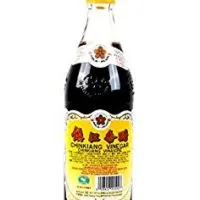 Gold Plum Chinkiang Vinegar 18.6 fl oz
Gold Plum Chinkiang Vinegar 18.6 fl oz -
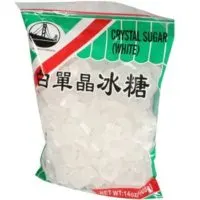 Chic Crystal White Sugar 14 oz
Chic Crystal White Sugar 14 oz -
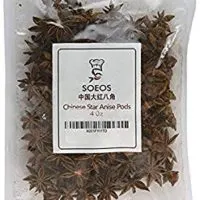 Soeos Star Anise Seeds (Anis Estrella), Whole Chinese Star Anise Pods, Dried Anise Star Spice, 4 oz.
Soeos Star Anise Seeds (Anis Estrella), Whole Chinese Star Anise Pods, Dried Anise Star Spice, 4 oz. -
 AccuWeight 207 Digital Kitchen Multifunction Food Scale for Cooking with Large Back-lit LCD Display,Easy to Clean with Precision Measuring,Tempered Glass, 0, Silver
AccuWeight 207 Digital Kitchen Multifunction Food Scale for Cooking with Large Back-lit LCD Display,Easy to Clean with Precision Measuring,Tempered Glass, 0, Silver
Nutrition Information:
Yield:
2Serving Size:
2 servingsAmount Per Serving: Calories: 1115Total Fat: 83gSaturated Fat: 25gTrans Fat: 1gUnsaturated Fat: 37gCholesterol: 281mgSodium: 2317mgCarbohydrates: 31gFiber: 3gSugar: 1gProtein: 61g
This data was provided and calculated by Nutritionix on 6/2/2019

Marga
Saturday 19th of June 2021
This recipe was absolutely delicious. It's time consuming, but relatively easy to make and doesn't require a lot of active time. I omitted the red rice and used sweetened black vinegar, as I wasn't going for red color anyway. I made it as my exploration of Jiangsu cuisine. Thanks for posting it.
KP Kwan
Saturday 19th of June 2021
So glad that you like this recipe :)
Zaur
Wednesday 13th of May 2020
What a great, detailed recipe. Would it be possible to use aged vinegar (8yrs) — the one used with soup dumplings or hot and sour soup — as a substitute for the red vinegar?
KP Kwan
Thursday 14th of May 2020
Hi Zaur, The aged vinegar you mentioned works well for this recipe too. Enjoy! KP Kwan
Pathma V
Sunday 17th of November 2019
Hello KP, i just stumbled into your blog when i was searching for answers to my steam buns. I am interested in your wuxi pork ribs recipe and have read through, however i was curious about Michael's question about marinating overnight. I don't see any water to be added. It is only salt and soy sauce.
KP Kwan
Sunday 17th of November 2019
Hi Pathma, I need to clarify that I oversight the water, as mentioned. There is no water required, only the ribs + soy sauce + ribs, and then overnight. Sorry for the confusion. Thanks, KP Kwan
MIchael
Sunday 26th of August 2018
Hi there, point of clarification, are you saying to marinate just in water and salt overnight? Thanks.
KP Kwan
Sunday 26th of August 2018
I have just replied to your the earlier same question. Wish to enjoy the Chinese Wuxi pork ribs.
Michael
Sunday 26th of August 2018
Hi! Just to clarify, are you saying to marinate with just water and salt overnight?
Tina ketner
Sunday 18th of December 2022
@KP Kwan, when do I put the sugar in there's no D ingredient instructions. And I'm in the middle of making it right now
KP Kwan
Sunday 26th of August 2018
Hi Michael, Yes, it is. The reason is overnight marination of salt will cause the salt to penetrate and stay with the meat, even after the treatment with blanching. That gives them meat with the same saltiness even at the thicker part of the ribs. The flavor with being added to the ribs during braising, from the herbs and seasonings. Thanks, KP Kwan